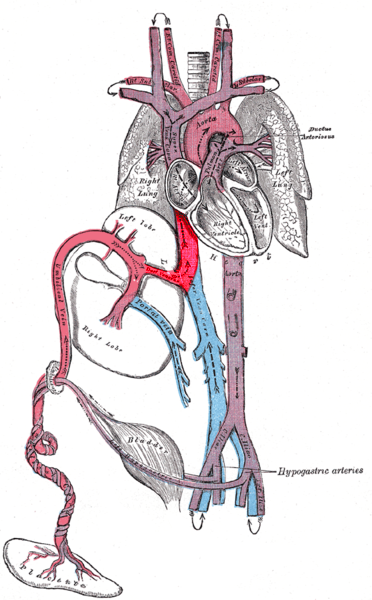[2]
Morton SU, Brodsky D. Fetal Physiology and the Transition to Extrauterine Life. Clinics in perinatology. 2016 Sep:43(3):395-407. doi: 10.1016/j.clp.2016.04.001. Epub 2016 Jun 11
[PubMed PMID: 27524443]
[3]
Braga M, Moleiro ML, Guedes-Martins L. Clinical Significance of Ductus Venosus Waveform as Generated by Pressure- volume Changes in the Fetal Heart. Current cardiology reviews. 2019:15(3):167-176. doi: 10.2174/1573403X15666190115142303. Epub
[PubMed PMID: 30644348]
[4]
Poeppelman RS, Tobias JD. Patent Ductus Venosus and Congenital Heart Disease: A Case Report and Review. Cardiology research. 2018 Oct:9(5):330-333. doi: 10.14740/cr777w. Epub 2018 Oct 7
[PubMed PMID: 30344833]
Level 3 (low-level) evidence
[6]
Nasu T, Arishima K. Development of the ductus venosus in the SD rat. Fukuoka igaku zasshi = Hukuoka acta medica. 2004 Jan:95(1):9-16
[PubMed PMID: 15031995]
[7]
Edelstone DI. Regulation of blood flow through the ductus venosus. Journal of developmental physiology. 1980 Aug:2(4):219-38
[PubMed PMID: 7012226]
[8]
Turan S, Turan OM. Harmony Behind the Trumped-Shaped Vessel: the Essential Role of the Ductus Venosus in Fetal Medicine. Balkan medical journal. 2018 Mar 15:35(2):124-130. doi: 10.4274/balkanmedj.2017.1389. Epub
[PubMed PMID: 29553462]
[9]
Gürses C, Karadağ B, İsenlik BST. Normal variants of ductus venosus spectral Doppler flow patterns in normal pregnancies. The journal of maternal-fetal & neonatal medicine : the official journal of the European Association of Perinatal Medicine, the Federation of Asia and Oceania Perinatal Societies, the International Society of Perinatal Obstetricians. 2020 Apr:33(8):1288-1294. doi: 10.1080/14767058.2018.1517323. Epub 2018 Oct 1
[PubMed PMID: 30153762]
[10]
Contratti G, Banzi C, Ghi T, Perolo A, Pilu G, Visentin A. Absence of the ductus venosus: report of 10 new cases and review of the literature. Ultrasound in obstetrics & gynecology : the official journal of the International Society of Ultrasound in Obstetrics and Gynecology. 2001 Dec:18(6):605-9
[PubMed PMID: 11844198]
Level 3 (low-level) evidence
[11]
Maiz N, Valencia C, Kagan KO, Wright D, Nicolaides KH. Ductus venosus Doppler in screening for trisomies 21, 18 and 13 and Turner syndrome at 11-13 weeks of gestation. Ultrasound in obstetrics & gynecology : the official journal of the International Society of Ultrasound in Obstetrics and Gynecology. 2009 May:33(5):512-7. doi: 10.1002/uog.6330. Epub
[PubMed PMID: 19338027]
[12]
Maiz N, Plasencia W, Dagklis T, Faros E, Nicolaides K. Ductus venosus Doppler in fetuses with cardiac defects and increased nuchal translucency thickness. Ultrasound in obstetrics & gynecology : the official journal of the International Society of Ultrasound in Obstetrics and Gynecology. 2008 Mar:31(3):256-60. doi: 10.1002/uog.5262. Epub
[PubMed PMID: 18307193]
[13]
Oh C, Harman C, Baschat AA. Abnormal first-trimester ductus venosus blood flow: a risk factor for adverse outcome in fetuses with normal nuchal translucency. Ultrasound in obstetrics & gynecology : the official journal of the International Society of Ultrasound in Obstetrics and Gynecology. 2007 Aug:30(2):192-6
[PubMed PMID: 17518423]
[14]
Araki T, Kamada M, Okamoto Y, Arai S, Oba O. Coil embolization of a patent ductus venosus in a 52-day-old girl with congenital heart disease. The Annals of thoracic surgery. 2003 Jan:75(1):273-5
[PubMed PMID: 12537231]
[15]
Jacob S, Farr G, De Vun D, Takiff H, Mason A. Hepatic manifestations of familial patent ductus venosus in adults. Gut. 1999 Sep:45(3):442-5
[PubMed PMID: 10446116]
[16]
Lund A, Ebbing C, Rasmussen S, Kiserud T, Kessler J. Maternal diabetes alters the development of ductus venosus shunting in the fetus. Acta obstetricia et gynecologica Scandinavica. 2018 Aug:97(8):1032-1040. doi: 10.1111/aogs.13363. Epub 2018 Jun 20
[PubMed PMID: 29752712]


